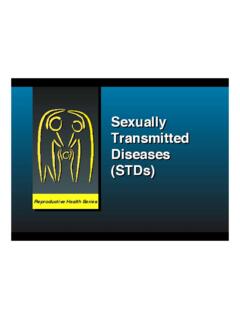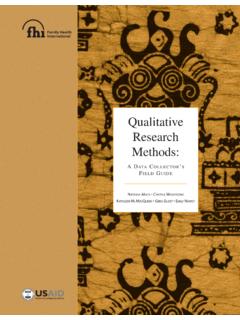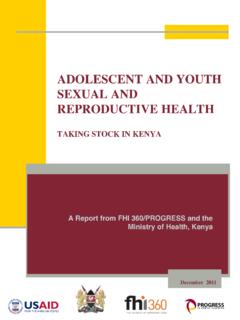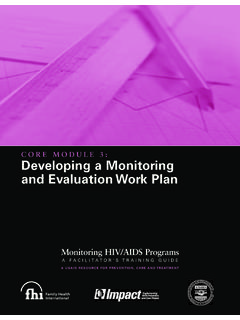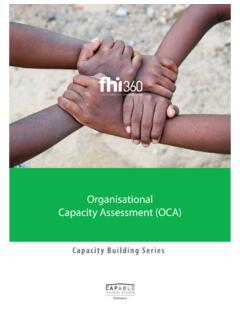Transcription of Nursing Care of Patients with HIV: Participant's Guide
1 Nursing care of Patients with HIV/AIDS. Nurses provide life-saving and life-enriching care throughout the world. Often they are the first provider or even the primary provider for Patients with HIV. While medically focused trainings provide a valuable service to the doctors in HIV care, nurses need training geared to their competencies and roles. To equip nurses in resource- limited areas with this specialized training, Family Health International has developed Nursing Care of Patients with HIV/AIDS. This curriculum is intended for nurses working in facilities ranging from the primary-level health center to the tertiary-level hospital who work in a variety of roles to provide care to those with HIV. As education levels and experience vary, the curriculum was designed to be comprehensive: it includes 15 modules, a facilitator's Guide , and a Participant's Guide .
2 Thus, the length of the course can be tailored to fit individual needs. Nursing care of Patients with hiv/aids Participant's Guide Participant's Guide Family Health International 2101 Wilson Boulevard, Suite 700. Arlington, VA 22201. t f ISBN 1-933702-16-8. PN-ADK-152. In July 2011, FHI became FHI 360. FHI 360 is a nonprofit human development organization dedicated to improving lives in lasting ways by advancing integrated, locally driven solutions. Our staff includes experts in health, education, nutrition, environment, economic development, civil society, gender, youth, research and technology creating a unique mix of capabilities to address today's interrelated development challenges. FHI 360 serves more than 60 countries, all 50 states and all territories.
3 Visit us at Nursing care of Patients with hiv/aids Participant's Guide 2007 Family Health International (FHI). All rights reserved. This document was funded by the US. Agency for International Development (USAID) through FHI's Implementing AIDS Prevention and Care (IMPACT) project, Cooperative Agreement HRN-A-00-97-00017-00. Co ntents Abbreviations and Glossary .. iii Introduction to the training manual .. vii Acknowledgments.. ix Course description..x Introductory session .. 3. Session 1: Comprehensive Nursing care of PLHA .. 7. Session 2: Special issues for nurses .. 21. Session 3: HIV basics.. 33. Session 4: Standard precautions and infection control .. 53. Session 5: Common conditions experienced by PLHA .. 65.
4 Session 6: Palliative care.. 107. Session 7: Nutrition.. 119. Session 8: Prevention within care.. 133. Session 9: Antiretroviral therapy.. 139. Session 10: Special issues for childbearing women .. 161. Session 11: Special issues in pediatrics .. 173. Session 12: Assessing readiness for ART.. 209. Session 13: Nursing management of ARV side effects.. 213. Session 14: Helping the patient understand and adhere to ART.. 223. Session 15: ARV regimen change.. 237. Course wrap-up and evaluation.. 245. References .. 247. Essential drug list.. 257. Nursing Care of Patients with HIV/AIDS Facilitator's Guide i ii Nursing Care of Patients with HIV/AIDS Facilitator's Guide abbre vi at ions and G l o s s a ry TERM DEFINITION. ADL Activities of daily living: the basic tasks a person has to do to go about everyday life, including eating, bathing, toileting, dressing, etc.
5 AIDS Acquired immune deficiency syndrome: the late stage of HIV disease. A person is diagnosed with AIDS when his CD4 cell count is below 200 per ml3 of blood or he has experienced certain illnesses (AIDS-defining illnesses). ART Antiretroviral therapy: the combination treatment for HIV using more than two antiretroviral drugs (ARVs). ARV Antiretroviral: a drug or combination of drugs used to fight the HIV virus; together, as ART, they make it difficult for HIV to multiply. ARV classes ART drugs are grouped into classes depending on how they work to fight the virus. Classes include nucleoside (and nucleotide) reverse transcriptase inhibitors, non- nucleoside reverse transcriptase inhibitors, protease inhibitors, and fusion inhibitors.
6 Bd Twice a day. CD4 cells A type of immune system cell that fights certain infections. These cells are the primary target of the HIV virus. How well the immune system is functioning can be determined by counting the number of CD4 cells per ml3 of blood. CT Counseling and testing (also called voluntary counseling and testing, or VCT). CTX cotrimoxazole, also called Septrim. Comprehensive A multidisciplinary approach used to assist HIV-positive Patients and their families. care It addresses the multitude of biologic and socioeconomic factors involved in HIV. disease. first-line The combination of drugs that is usually used first for ART. Nursing Care of Patients with HIV/AIDS Facilitator's Guide iii FTC Emtricitabine.
7 HIV Human immunodeficiency virus: the virus that causes HIV disease and AIDS. immune system The system in the body that fights off infection. infection An infection is caused by a bacteria, fungus, or virus. The body can naturally fight off some infections while others cause illnesses. IPD Inpatient department. IV Intravenous. OPD Outpatient department. opportunistic An infection that occurs in a person with a weak immune system. infection (OI). PEP postexposure prophylaxis : treatment with ART to prevent the transmission of HIV. when a person has been exposed. PLHA People living with HIV or AIDS. PMTCT Prevention of mother-to-child transmission of HIV. PO By mouth. PPD A skin test done to test for tuberculosis. prophylaxis Treating an infection before it occurs.
8 Patients may receive prophylactic treatment for common OIs with the idea that it is likely that they may get the OI; or they may receive secondary prophylaxis if they have had a certain OI and it is likely that they may get it again. (Also see PEP.). resistance The ability of the HIV virus to change and resist the ability of some drugs to work against it. iv Nursing Care of Patients with HIV/AIDS Facilitator's Guide second-line The combination of drugs that is usually used to treat HIV once first-line drugs have failed. side effects/ Symptoms or problems caused by taking drugs; symptoms may range from minor to toxicities major. STD Sexually transmitted disease or infection. TB Tuberculosis. TB/HIV co- Infection with both TB and HIV.
9 Infection viral load A blood test that counts the amount of HIV virus in the blood. A higher viral load indicates that there is more virus in the person's blood and the person is sicker. viral replication The process of how a virus makes copies of itself. window period The period of time after a person is infected with the HIV virus during which he still tests negative (about 3 months or 13 wks). Nursing Care of Patients with HIV/AIDS Facilitator's Guide v vi Nursing Care of Patients with HIV/AIDS Facilitator's Guide intr o duction Nurses provide life-saving and life-enriching care throughout the world. Often they are the first provider or even the primary provider for Patients with HIV. While medically focused trainings provide a valuable service to the doctors in HIV care, nurses need training that is geared to their competencies and roles.
10 To equip nurses in resource- limited areas with this specialized training, Family Health International has developed Nursing Care of Patients with HIV/AIDS. This curriculum is intended for nurses working in facilities ranging from the primary-level health center to the tertiary-level hospital who work in a variety of roles to provide care to those with HIV. Design of the Curriculum As education levels and experience vary, the curriculum was designed to be comprehensive: it includes 15 modules, a facilitator's Guide , and a Participant's Guide . The length of the course can be tailored to fit individual needs. The program in the facilitator's Guide has been designed for a five-day agenda, but a seven-day agenda is also included.

